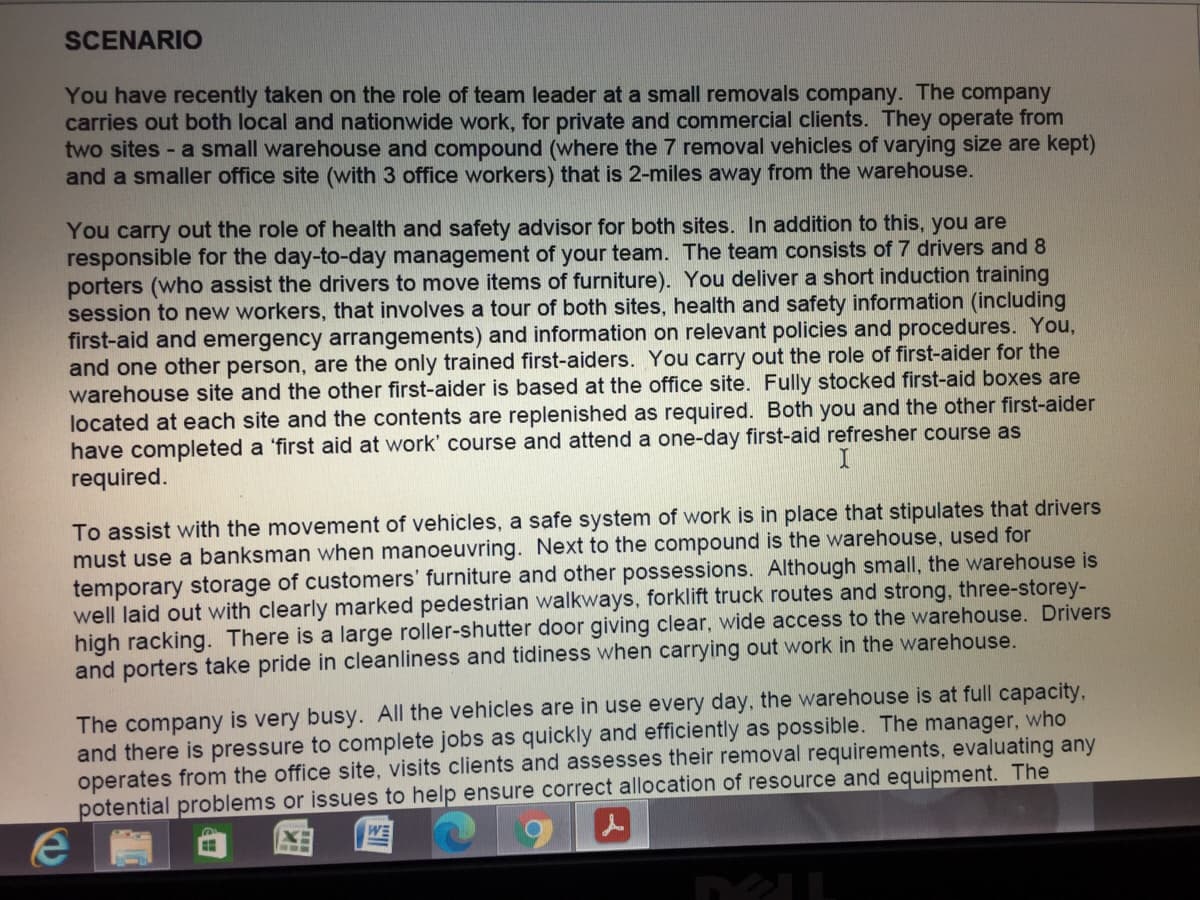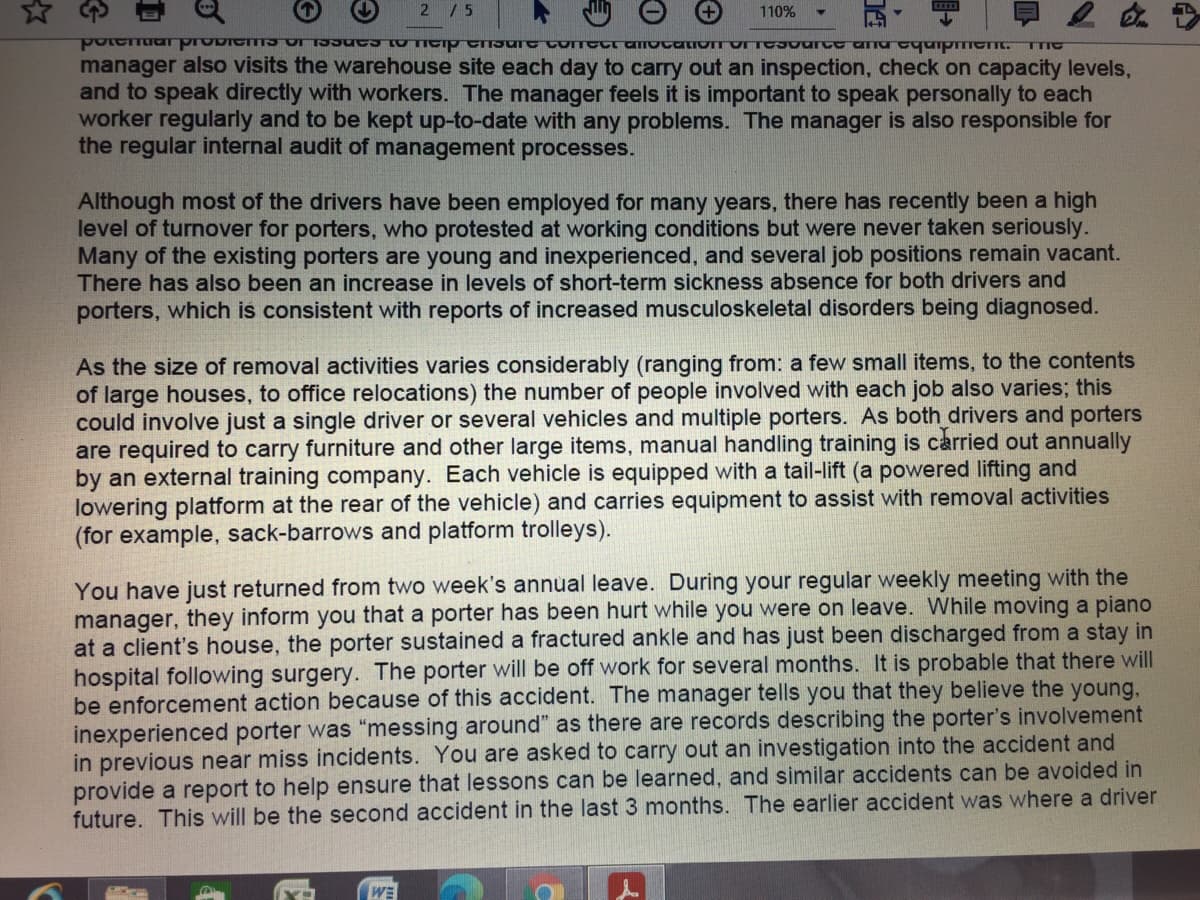You have recently taken on the role of team leader at a small removals company. The company carries out both local and nationwide work, for private and commercial clients. They operate from two sites - a small warehouse and compound (where the 7 removal vehicles of varying size are kept) and a smaller office site (with 3 office workers) that is 2-miles away from the warehouse. You carry out the role of health and safety advisor for both sites. In addition to this, you are responsible for the day-to-day management of your team. The team consists of 7 drivers and 8 porters (who assist the drivers to move items of furniture). You deliver a short induction training session to new workers, that involves a tour of both sites, health and safety information (including first-aid and emergency arrangements) and information on relevant policies and procedures. You, and one other person, are the only trained first-aiders. You carry out the role of first-aider for the warehouse site and the other first-aider is based at the office site. Fully stocked first-aid boxes are located at each site and the contents are replenished as required. Both you and the other first-aider have completed a 'first aid at work' course and attend a one-day first-aid refresher course as required. I. To assist with the movement of vehicles, a safe system of work is in place that stipulates that drivers must use a banksman when manoeuvring. Next to the compound is the warehouse, used for temporary storage of customers' furniture and other possessions. Although small, the warehouse is well laid out with clearly marked pedestrian walkways, forklift truck routes and strong, three-storey- high racking. There is a large roller-shutter door giving clear, wide access to the warehouse. Drivers and porters take pride in cleanliness and tidiness when carrying out work in the warehouse. The company is very busy. All the vehicles are in use every day, the warehouse is at full capacity, and there is pressure to complete jobs as quickly and efficiently as possible. The manager, who operates from the office site, visits clients and assesses their removal requirements, evaluating any notontial problems or issues to help ensure correct allocation of resource and equipment. The
You have recently taken on the role of team leader at a small removals company. The company carries out both local and nationwide work, for private and commercial clients. They operate from two sites - a small warehouse and compound (where the 7 removal vehicles of varying size are kept) and a smaller office site (with 3 office workers) that is 2-miles away from the warehouse. You carry out the role of health and safety advisor for both sites. In addition to this, you are responsible for the day-to-day management of your team. The team consists of 7 drivers and 8 porters (who assist the drivers to move items of furniture). You deliver a short induction training session to new workers, that involves a tour of both sites, health and safety information (including first-aid and emergency arrangements) and information on relevant policies and procedures. You, and one other person, are the only trained first-aiders. You carry out the role of first-aider for the warehouse site and the other first-aider is based at the office site. Fully stocked first-aid boxes are located at each site and the contents are replenished as required. Both you and the other first-aider have completed a 'first aid at work' course and attend a one-day first-aid refresher course as required. I. To assist with the movement of vehicles, a safe system of work is in place that stipulates that drivers must use a banksman when manoeuvring. Next to the compound is the warehouse, used for temporary storage of customers' furniture and other possessions. Although small, the warehouse is well laid out with clearly marked pedestrian walkways, forklift truck routes and strong, three-storey- high racking. There is a large roller-shutter door giving clear, wide access to the warehouse. Drivers and porters take pride in cleanliness and tidiness when carrying out work in the warehouse. The company is very busy. All the vehicles are in use every day, the warehouse is at full capacity, and there is pressure to complete jobs as quickly and efficiently as possible. The manager, who operates from the office site, visits clients and assesses their removal requirements, evaluating any notontial problems or issues to help ensure correct allocation of resource and equipment. The
Cornerstones of Cost Management (Cornerstones Series)
4th Edition
ISBN:9781305970663
Author:Don R. Hansen, Maryanne M. Mowen
Publisher:Don R. Hansen, Maryanne M. Mowen
Chapter1: Introduction To Cost Management
Section: Chapter Questions
Problem 12P: Emery Manufacturing Company produces component parts for the farm equipment industry and has...
Related questions
Question
100%
Answer

Transcribed Image Text:SCENARIO
You have recently taken on the role of team leader at a small removals company. The company
carries out both local and nationwide work, for private and commercial clients. They operate from
two sites - a small warehouse and compound (where the 7 removal vehicles of varying size are kept)
and a smaller office site (with 3 office workers) that is 2-miles away from the warehouse.
You carry out the role of health and safety advisor for both sites. In addition to this, you are
responsible for the day-to-day management of your team. The team consists of 7 drivers and 8
porters (who assist the drivers to move items of furniture). You deliver a short induction training
session to new workers, that involves a tour of both sites, health and safety information (including
first-aid and emergency arrangements) and information on relevant policies and procedures. You,
and one other person, are the only trained first-aiders. You carry out the role of first-aider for the
warehouse site and the other first-aider is based at the office site. Fully stocked first-aid boxes are
located at each site and the contents are replenished as required. Both you and the other first-aider
have completed a 'first aid at work' course and attend a one-day first-aid refresher course as
required.
To assist with the movement of vehicles, a safe system of work is in place that stipulates that drivers
must use a banksman when manoeuvring. Next to the compound is the warehouse, used for
temporary storage of customers' furniture and other possessions. Although small, the warehouse is
well laid out with clearly marked pedestrian walkways, forklift truck routes and strong, three-storey-
high racking. There is a large roller-shutter door giving clear, wide access to the warehouse. Drivers
and porters take pride in cleanliness and tidiness when carrying out work in the warehouse.
The company is very busy. All the vehicles are in use every day, the warehouse is at full capacity,
and there is pressure to complete jobs as quickly and efficiently as possible. The manager, who
operates from the office site, visits clients and assesses their removal requirements, evaluating any
potential problems or issues to help ensure correct allocation of resource and equipment. The
WE

Transcribed Image Text:☆や
2 /5
110%
PU P ण ग्प्ण पापणाप्पचाण्प्यपणाणाप्यण्पाप् वाप शानात.
manager also visits the warehouse site each day to carry out an inspection, check on capacity levels,
and to speak directly with workers. The manager feels it is important to speak personally to each
worker regularly and to be kept up-to-date with any problems. The manager is also responsible for
the regular internal audit of management processes.
TTIC
Although most of the drivers have been employed for many years, there has recently been a high
level of turnover for porters, who protested at working conditions but were never taken seriously.
Many of the existing porters are young and inexperienced, and several job positions remain vacant.
There has also been an increase in levels of short-term sickness absence for both drivers and
porters, which is consistent with reports of increased musculoskeletal disorders being diagnosed.
As the size of removal activities varies considerably (ranging from: a few small items, to the contents
of large houses, to office relocations) the number of people involved with each job also varies; this
could involve just a single driver or several vehicles and multiple porters. As both drivers and porters
are required to carry furniture and other large items, manual handling training is carried out annually
by an external training company. Each vehicle is equipped with a tail-lift (a powered lifting and
lowering platform at the rear of the vehicle) and carries equipment to assist with removal activities
(for example, sack-barrows and platform trolleys).
You have just returned from two week's annual leave. During your regular weekly meeting with the
manager, they inform you that a porter has been hurt while you were on leave. While moving a piano
at a client's house, the porter sustained a fractured ankle and has just been discharged from a stay in
hospital following surgery. The porter will be off work for several months. It is probable that there will
be enforcement action because of this accident. The manager tells you that they believe the young,
inexperienced porter was "messing around" as there are records describing the porter's involvement
in previous near miss incidents. You are asked to carry out an investigation into the accident and
provide a report to help ensure that lessons can be learned, and similar accidents can be avoided in
future. This will be the second accident in the last 3 months. The earlier accident was where a driver
Expert Solution
This question has been solved!
Explore an expertly crafted, step-by-step solution for a thorough understanding of key concepts.
Step by step
Solved in 2 steps

Recommended textbooks for you

Cornerstones of Cost Management (Cornerstones Ser…
Accounting
ISBN:
9781305970663
Author:
Don R. Hansen, Maryanne M. Mowen
Publisher:
Cengage Learning

Managerial Accounting: The Cornerstone of Busines…
Accounting
ISBN:
9781337115773
Author:
Maryanne M. Mowen, Don R. Hansen, Dan L. Heitger
Publisher:
Cengage Learning

Cornerstones of Cost Management (Cornerstones Ser…
Accounting
ISBN:
9781305970663
Author:
Don R. Hansen, Maryanne M. Mowen
Publisher:
Cengage Learning

Managerial Accounting: The Cornerstone of Busines…
Accounting
ISBN:
9781337115773
Author:
Maryanne M. Mowen, Don R. Hansen, Dan L. Heitger
Publisher:
Cengage Learning